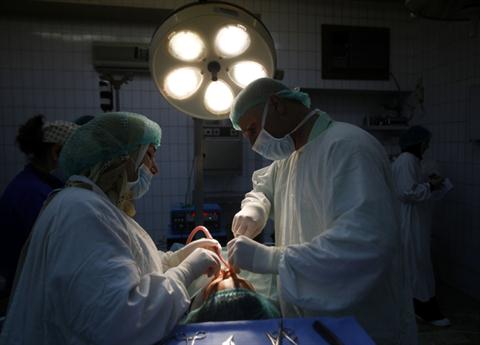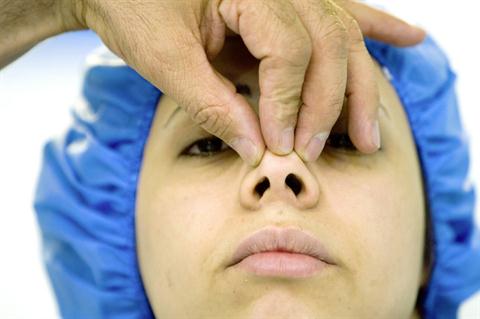
Beirut:
Summer seems to bring out some of the stereotypes most closely associated with Lebanon: street fighting, beach parties, fresh cosmetic surgery scars.
In this latter category, surgeons are saying the demand among Lebanese is higher than ever, but a huge client base, Gulf and Arab tourists, are shying away this year, due to the recent string of security incidents, and warnings issued from their embassies.
At the Hazmieh International Medical Center, general manager, medical director and facial cosmetic surgeon Dr. Elias Chammas says demand among Lebanese has risen consistently since the center opened in 1998.
 Rhinoplasty remains the most popular surgery performed on men and women
Rhinoplasty remains the most popular surgery performed on men and women
Rhinoplasty, or the nose job, has remained the firm No. 1 favorite, performed on girls from the age of 16, and followed, he says, by breast augmentation, liposuction and eyelid lifts. Less common, but still conducted, are hymenoplasty and anterior vaginal wall repair surgery, usually carried out, Chammas says, “if you have delivered four or five babies, you have a wider vagina and the husband or boyfriend is not happy with it.”
The only new trend that he can discern is the increase in male customers.
“At the beginning we had very few men coming in; now they account for around 30 percent of surgeries,” he says, adding that the most common procedures are hair transplants, rhinoplasty, liposuction, face lifts and breast reductions, this last surgery being performed at the center once or twice every month.
Penis enlargement surgery is less common, with one procedure performed every three or four months.
But this summer, patient numbers have fallen drastically.
“When it is stable, we have a lot of patients coming from the Gulf, around 40-45 percent,” Chammas says. “When the situation is bad, people don’t come.”
“This is the first time in 13 years when countries are actually telling their citizens not to come; usually they just tell them to be careful.”
In May, the United Arab Emirates, Kuwait, Qatar and Bahrain urged their citizens to consider leaving Lebanon, after deadly clashes in the northern city of Tripoli left 11 dead, although some of the warnings were later downgraded.
The Lebanese diaspora, while not quite as cautious as the Gulf medical tourists, are still not coming in the same numbers, Chammas adds.
Dr. Antoine Abi Abboud, who has an office at the Beirut Beauty Clinic in Zalka, and who routinely travels to the Gulf to work, agrees with Chammas’ assessment.
Last year around 35 percent of his patients were from the Gulf and Iraq, but now, “It doesn’t look so good, this is normally the most popular time of year for these clients. They are not coming these days due to the circumstances.”
Lebanon has traditionally been a favored cosmetic surgery destination among regional medical tourists due to the reputation of the country’s doctors, mostly trained in the United States, and the price of surgeries here.
Whereas a nose job could cost about $10,000 in Australia, here the price is around $2,500, Abi Abboud says.
Like Chammas, Abi Abboud has also seen a rise in male patients, with hair transplants and rhinoplasty again the most common procedures, and breast reductions increasingly popular.
While perhaps surprisingly, given its reputation, Lebanon fails to grace the rankings for highest rates of cosmetic surgery procedures per capita – Hungary and South Korea topped a 2010 survey – it is thought that this country has the highest number of plastic surgeons per head.
The background to this, some believe, lies with the Civil War and the need at that time for plastic surgeons capable of dealing with physical disfigurements.
But there are concerns the industry has spun out of control, due to a lack of enforced regulation. While there are only around 80 members of the Lebanese Society of Plastic Reconstructive and Aesthetic Surgery, which self-regulates, there are another 300 operating outside this syndicate.
All of the cosmetic surgeons at the Hazmieh center are members of the LSPRAS, Chammas says. “If you are related to this syndicate, it means you are good,” he says. “Otherwise, they could chuck you out.”
Recently there has been an increase in doctors of other branches of medicine – physiotherapists or pharmacists, for example – who buy up ad time on TV, promoting their clinic, and then they “bring a plastic surgeon in who they pay maybe $1,000 and then they charge the patient maybe $4,000,” Chammas says.
“You have a physiotherapist giving a lecture about face-lifts on TV. They are not qualified to do that.”
“There should be more control on who should do what,” Chammas adds, but he says he cannot pinpoint where the blame should lie.
The industry has come under increasing scrutiny recently, on charges that the proliferation of cosmetic surgery in Lebanon is creating an unrealistic standard of beauty, and contributing to the objectification of women, but Chammas denies that too many people are getting plastic surgery.
“Everybody is saying that, but I don’t understand the problem,” he says. Comparing cosmetic procedures to wearing makeup, Chammas believes it hypocritical to criticize the industry unless one is prepared to “have a bath and then walk in the streets like that. Don’t put makeup on, don’t put eye shadow on, don’t pluck your eyebrows.”
“You want to look at ease with yourself, [and] you either do it by wearing makeup, or clothing, or, if there is a physical deformity in the face, you come and correct it with plastic surgery. It’s the same.”
In the U.S., which has the highest overall number of cosmetic procedures in the world, every patient seeking treatment must first undergo a psychiatric screening.
For Chammas, such a process is unfeasible in Lebanon.
“We cannot do that. If you tell the patient that he has to see a psychiatrist, you will never see him again. The attitude toward psychiatry in the States is completely different … in Lebanon if you tell someone they have to see a psychiatrist they would say, ‘What? You think I’m crazy?’ So we don’t do that.”
It is up to each surgeon to act as the psychiatrist here, he says.
“If the woman is asking to humiliate herself, we’re not going to do that,” Chammas says. “Or she brings me a photo of an artist and she wants the same nose. We can’t do that.”
For Abi Abboud, he will refer certain patients for psychiatry, as he has done in the past with male patients seeking breast augmentation as part of a sex change process.
“If I can see that the person is asking for things I do not want to do, then I send them to a psychiatrist. Then if I receive an OK, I will do it.”
For Myra Saad, an art therapist who works with body image and self-esteem issues, and who is this summer running a series of workshops on the issue, it would be a positive step for every cosmetic surgery procedure to be preceded by a psychiatric assessment.
“Each surgeon has his own ethics, but as a counselor, I think it should be required,” she says.
Of patients who keep going back for multiple surgeries, a phenomenon both surgeons defend, Saad says that while this may not be a symptom of body dysmorphia, it may indicate issues relating to self-esteem and identity.
“It’s so obvious that a lot of plastic surgery is about business, not about health,” she says.
She also thinks that the cosmetic surgery trend in Lebanon can be seen, in a way, as a rejection of local heritage, and an attempt to emulate Western norms of beauty.
“Media promotes this idea of what beauty is … beauty is no longer subjective,” she says.
The root problem, she believes, should be targeted at a young age, with “more media literacy classes, and empowerment and self-development workshops which teach confidence in the way you are.”
source: http://www.dailystar.com.lb / The Daily Star, Lebanon / Home> News> Lifestyle / by Olivia Alabaster / June 30th, 2012



